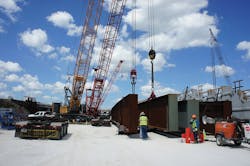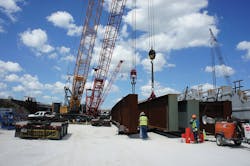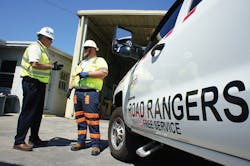By: Loreen Bobo, P.E.
Trying to list all the maintenance of traffic (MOT) challenges posed by the I-4 Ultimate project can be a project in itself.
The MOT challenge on I-4 is nothing less than what happens when the largest infrastructure project in Florida’s history is being built in the middle of the fastest-growing, top-25 metropolitan area in the nation. Even at the most basic level, the seven-year project will take thousands of lane shifts, closures and changes in traffic patterns to accommodate both travelers and construction. But it is even more complex than that.
I-4 already is the busiest highway in a bustling metro area. Indeed, Forbes magazine recently ranked Orlando as the fastest growing of the nation’s 25 largest metros and second-fastest in the nation overall. The city is home to 2 million residents, host to 68 million annual visitors and copes daily with an interchange that handles 200,000 vehicles per day at the city’s core, which sits astride many entertainment and business venues. The 21-mile I-4 Ultimate reconstruction effort not only runs through the downtown area, but it also passes right by Universal Orlando theme park and then becomes a main route to SeaWorld Orlando and Walt Disney World, which rises just beyond the western end of the project zone.
When completed, the project will have rebuilt all six lanes of I-4 across the 21-mile spread, constructed or widened 140 bridges, reconfigured 15 major intersections and added four express lanes (two in each direction). The $2.3 billion reconstruction effort—a public-private partnership managed by the Florida Department of Transportation (FDOT)—began its final design stages in 2014 and construction activities in 2015. It is scheduled to be completed in 2021.
Meeting this deadline means dealing with a constant and pressing need to keep traffic flowing while the team builds a signature corridor to improve safety and mobility. The project partners realized ahead of time they would face a complex, multilayered MOT challenge that included everything from temporary ramps to ongoing public messaging to keep traffic moving safely and efficiently.
With lane shifts, closures, detours and rolling roadblocks, there can be 400 or more MOT actions during a typical month. A recent count done by the project’s MOT team puts the number at about 2,500 per year thus far. To minimize delays, FDOT requires six lanes of traffic remain open during busy daylight hours. That takes intensive planning and the best high-tech help available, including mobile messaging signs and dedicated text alert systems.
Yet, the I-4 Ultimate team also realized that maintaining a steady flow of traffic requires a steady stream of public information that’s both relevant and reliable. Informed motorists are safer motorists, and they are just as vital to MOT success as the newest technology. Whenever drivers check traffic conditions via the specialized I-4 Ultimate alerts system before hitting the road and adjust their plans accordingly, they improve safety and mobility for everyone.
The team’s multilayered MOT strategy includes:
- Hiring its own group of Road Rangers to ensure quick clearance of traffic incidents;
- Creating a first-of-its-kind alert system for email and text alerts to keep the public updated;
- Producing a weekly series of videos, narrated in English and Spanish, to inform of upcoming work via TV, radio and Internet;
- Finding and testing the best new technology to support work-zone safety for drivers and workers;
- Carrying out ongoing public information efforts, including digital platforms, media events, public meetings and outreach teams walking through affected neighborhoods to hand out flyers and door hangers;
- Maintaining a team of 30 MOT specialists, 10 foremen and seven superintendents; and
- Providing training for all MOT crew members through a partnership between SGL Constructors and the American Traffic Safety Services Association (ATSSA), and staffing a full-time trainer.
FDOT also requires that all traffic incidents be cleared in two hours. That contractual incentive helps prevent minor traffic incidents from developing into major backups.
New technology for safety and mobility
As the project continues to ramp up, there could be as many as 2,000 workers on I-4 Ultimate construction sites during a 24-hour work cycle. That means safety issues will continue to grow more complex as the work proceeds.
While there are many parts to the MOT strategy, the safety measures and mobility tactics employed to protect workers and motorists are handled in major part by SGL Constructors—the construction joint venture of Skanska, Granite and Lane. And the SGL MOT team has made it a priority to try out new products that have shown strong promise, and look for innovative technologies and special equipment to minimize congestion and lower the risk of collisions.
The team set up Florida’s first smart work zone. The system uses radar devices and a camera (that does not store images) to monitor traffic speed along a portion of the project. If it detects congestion, the system automatically sends warnings to three electronic message signs on the roadside. The lighted display boards alert drivers to possible slowdowns ahead. This helps prevent oncoming drivers from rear-ending slower or stopped traffic.
The smart work-zone system is mobile and can be controlled by secure cell phones, saving the time and expense of sending a team member out to change a message. It also limits the time workers spend on the shoulders of a busy interstate.
Additionally, the I-4 Ultimate team designed a special package of safety features for attenuator trucks. The attenuator trucks each have a 13-ft-long, collapsible shock absorber mounted on the back to protect workers and oncoming drivers in the event of a rear-end collision. The features also include platforms for workers to place and retrieve up to 500 traffic cones, a flashing arrow sign that can be raised and lowered, an intercom system to communicate with workers in the back of the truck, and cameras so drivers don’t have to turn around to check on vehicles behind them.
The MOT team also is testing programmable lights that attach to the tops of traffic cones and can flash or blink in sequence. When drivers see a line of cones blinking in first-to-last order, it helps them recognize their lane is tapering toward a closure and they need to move over. If a cone is knocked over, the remaining lights wirelessly re-sync themselves using Bluetooth technology.
The new cone lights seem to have caught the attention of drivers. During a typical night, workers often find that three or four of the unlit, reflective cones are knocked over. However, none of the blinking cones had been hit during the first few weeks of use.
Another new safety feature undergoing testing is a worker alert system that appears to be a simple and effective measure. A long, air-filled hose is placed on the ground at the edge of a safe work zone. If a vehicle runs across it, then the unit sends a signal to portable alarms in the work zone that emit loud sirens and bright flashing lights. That notifies workers of a potential danger such as a speeding vehicle veering off course. Workers on the ground and those operating vehicles also can carry personal alarm devices that vibrate and flash when a vehicle crosses the hose into the work zone.
The Road Rangers provide 24/7 roadside assistance throughout the I-4 project site limits.
The Road Rangers
The need to keep six lanes open while rebuilding in tight quarters can create stretches of roadway that have narrow shoulders bounded by temporary concrete barrier walls.
That underscores the need for Road Rangers, who can help prevent traffic from backing up and protect stranded motorists. The I-4 Ultimate Road Ranger fleet includes 17 trucks and over 32 men and women. The roadside-assistance trucks are ready to roll 24 hours a day. During peak hours, the group may have as many as 10 vehicles on the road, dealing with disabled or abandoned cars, traffic accidents and debris in the roadway.
If they cannot make quick repairs safely and get motorists moving again, the Rangers can then help move a vehicle that is obstructing traffic, keep the motorists safe and help shield any responders who arrive.
In their first year, the I-4 Ultimate Road Rangers responded to approximately 20,500 incidents, and the team has met its goal of reaching trouble spots within 30 minutes in 99.8% of all cases. In fact, they reached drivers in need within 10 minutes almost 70% of the time.
When needed, the team also can call upon incident-management trucks. The trucks are equipped with cranes for moving disabled vehicles and tools for cleaning spills. The incident-management trucks can relieve a fire department hazardous-material crew and help Road Rangers and law enforcement get lanes opened more quickly.
Keeping motorists informed
A steady flow of traffic requires a steady flow of information.
Long-haul truckers, daily commuters, delivery drivers, parents in carpools and tourists all drive through the I-4 Ultimate project site, and they all share one ongoing need: Information to minimize delays.
The I-4 Ultimate team works to keep the motoring public informed through several platforms. These include mobile messaging, website content, information rack stands in highly visible places, media events and public meetings.
Knowing that there would be many traffic-pattern changes to work through during construction, the I-4 Ultimate team created a first-of-its-kind text and email messaging system that alerts users about lane shifts, ramp closures and rolling roadblocks on a weekly, daily and, when needed, immediate basis.
The overall outreach strategy includes media events, billboards, public speakers and ready-to-use information for interested groups. In an effort to keep interactions personalized, staff members have directly phoned and spoken with thousands of businesses and residents in affected areas. I-4 Ultimate teammates also walk through neighborhoods to leave informative flyers and door hangers, as appropriate.
The I-4 Ultimate website offers up-to-date information on traffic shifts and lane closures. It also introduces commuters and residents to those who work on the project through human-interest profiles. That helps drivers realize the human touch behind the machinery. It even may make them more likely to think about safety when driving past the people they have gotten to know through feature articles.
The Florida 511 Traveler Information System, which is also managed by FDOT, is another source of information about traffic conditions on I-4 and other interstates via text alerts, emails, phone calls, mobile apps and website visits. The I-4 Ultimate alerts system focuses solely on the project with details that include short-term lane changes within specified sectors. Florida 511, on the other hand, is a statewide system, so users can know about traffic conditions around the state.
Combining technical innovation and public information, the team works to keep traffic flowing safely while building a signature corridor that will support the region’s lifestyle and economy for decades to come.
-----------
About the author: Bobo is the I-4 Ultimate construction program manager for the Florida Department of Transportation.






